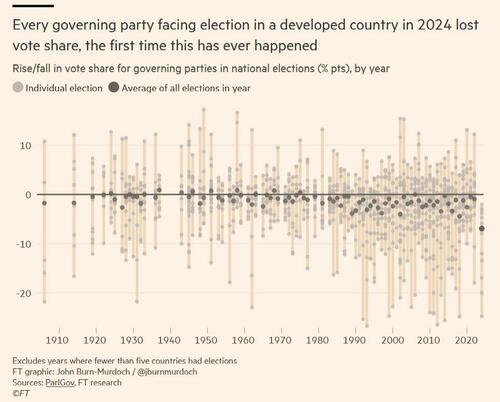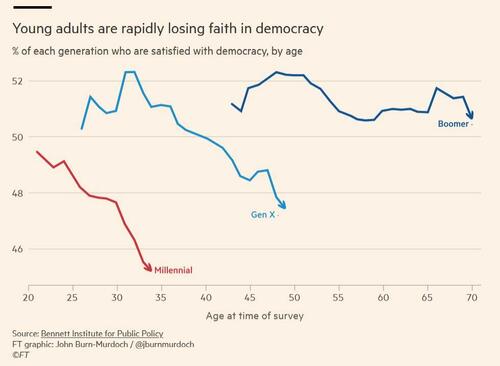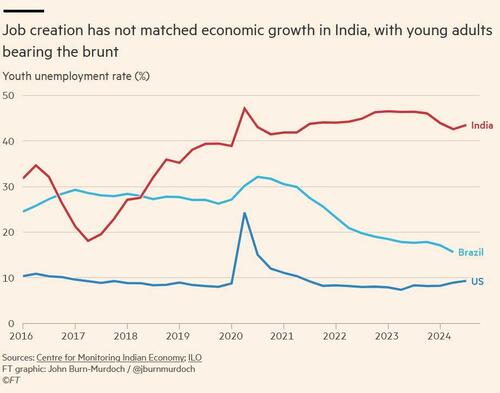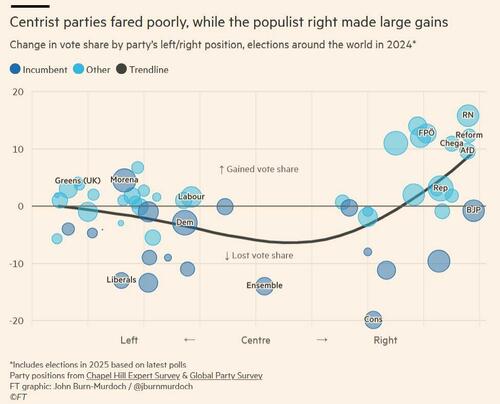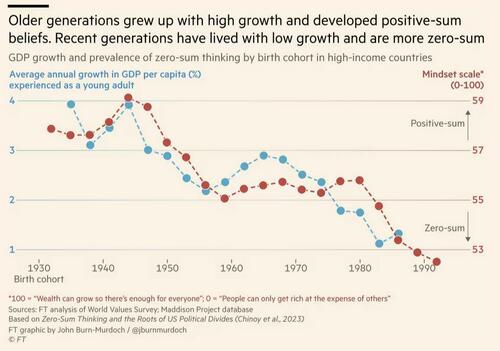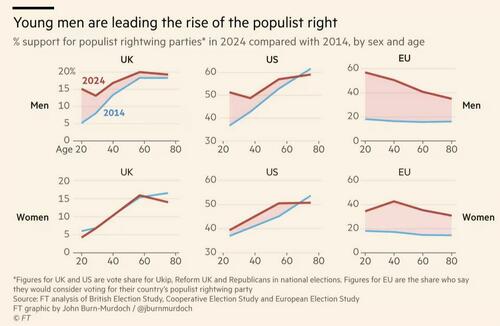Uddrag fra Financial Times/ Zerohedge:
In 2024, democracy spoke – and it roared with anger. With more than 1.5 billion votes cast across 73 nations, the political landscape was reshaped as incumbents and centrists faced unprecedented losses. From London to Tokyo, from Washington to Delhi, voters delivered a stinging rebuke to the status quo, catalyzing a seismic shift toward what were once considered political fringes.

For the first time in the history of modern democracy, every incumbent government in 12 developed Western nations suffered vote share losses, according to the Financial Times. The phenomenon extended to Asia, where the entrenched political machines of India and Japan faltered under the weight of economic and societal discontent. Across the board, centrists hemorrhaged support, with populists on the right – propelled by a surge of young male voters – emerging as the year’s biggest winners.
A Crisis of Confidence in Democracy
The message from voters was as clear as it was damning: democracy as it stands is failing. Stubbornly high inflation, economic stagnation, immigration tensions, and pervasive disillusionment coalesced into a perfect storm of dissatisfaction. On average, incumbents in developed nations saw a record-breaking seven-point drop in vote share – a fall more than twice as steep as the post-2008 global financial crisis punishment.
According to the report, young voters, many casting ballots for the first time, were particularly scathing in their rejection of establishment politics.
Inflation: The Universal Culprit
Coming into the year, inflation topped the list of public concerns in nearly every nation holding elections. Unlike recessions, whose pain points vary, inflation touches everyone, draining wallets and eroding trust in leadership. However, while inflation was a dominant factor, the full scope of discontent varied by region.
In the United Kingdom, voters ousted the ruling Conservatives after a bruising combination of high living costs, scandals, and a crumbling public healthcare system. Across the English Channel, French President Emmanuel Macron’s snap legislative elections backfired, plunging the country into political chaos.
India, long a bastion of economic growth, saw Prime Minister Narendra Modi’s Bharatiya Janata Party lose its parliamentary majority. While GDP growth remained robust, a glaring disconnect between job creation and economic expansion left nearly half of young adults unemployed.
This demographic’s frustrations fueled a surge in opposition support, particularly among first-time voters.
The Rise of Populism
If 2024 signaled the death knell for centrism, it also heralded the ascendancy of populism. In Mexico and Indonesia, Claudia Sheinbaum and Prabowo Subianto rode anti-elitist platforms to electoral victories, pledging continuity with their populist predecessors. Both campaigns leaned heavily on social media to bypass traditional power structures—a recurring strategy among successful outsider candidates.
Across Europe, conservative parties capitalized on rising immigration concerns. In France, the Rassemblement National recorded the largest vote swing of any party in the developed world this year, followed by Austria’s Freedom Party, Britain’s Reform UK, and Portugal’s Chega. The pattern was unmistakable: where traditional conservative parties faltered, populist challengers surged.
A Generational Divide
Beneath the headlines lies a deeper demographic shift. Young men, disillusioned by declining socio-economic prospects, overwhelmingly flocked to the populist right. In Britain, support for Reform UK among men in their early twenties outpaced that of older age groups.
A similar trend was evident in the United States, where young men swung sharply toward Donald Trump in November’s elections.
Meanwhile, young women gravitated toward alternatives on both extremes of the spectrum – Trump in the U.S., the Greens in the U.K. – illustrating a broader rejection of centrist politics among the under-30 demographic.
The Road Ahead
With 2025 upon us, the forces unleashed in 2024 show no signs of abating. Australia, Canada, Germany, and Norway are among the nations bracing for elections, with incumbents already trailing in polls. In many cases, it is once again the populist right poised to reap the benefits of a fragmented political landscape.
Though inflation has moderated somewhat, economic malaise, generational wealth gaps, and the pervasive influence of social media promise to keep the tides of discontent rolling. Democracy may have had its say in 2024, but the cry for change – whether reformist or radical – remains deafening.


